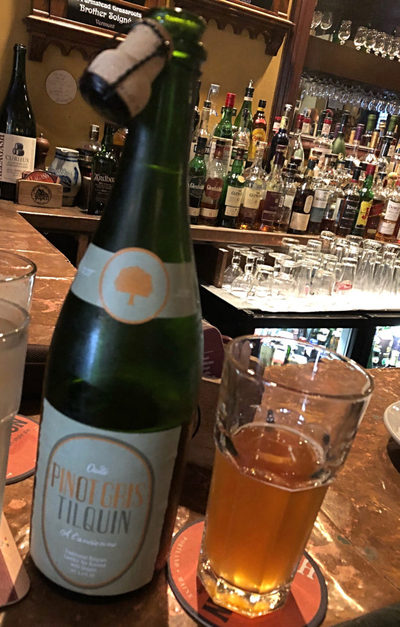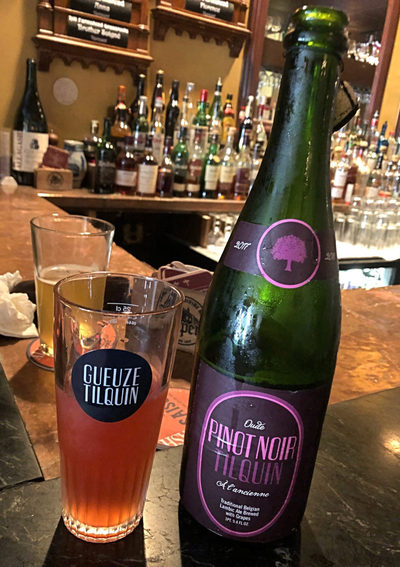Back in the day, I wasn’t especially enamored with sour beers. Like the scared apes at the beginning of 2001, I’d cautiously approach the sour beer monolith and give it a tap every now and again, but it wasn’t until I drank a bottle of Oude Gueuze Tilquin that I became a true believer. Obviously, I’ve since expanded my horizons considerably, but I’ll always have a special place in my beery heart for Tilquin. They have slowly been introducing new fruited variants over the years (and are planning an expansion to drastically increase these offerings). A few weeks ago marked the worldwide debut of Oude Pinot Gris Tilquin. As it happens, Monk’s Cafe had some bottles on hand for that event, and while there, I also got to try some of the Oude Pinot Noir Tilquin. Both are rather nice!
Oude Pinot Gris Tilquin à L’Ancienne – Made with 280 gr of, you guessed it, Pinot Gris grapes per liter of lambic. Looks like your standard gueuze offering, golden and a little cloudy, with minimal head. Smells nice, that vinous character coming through well, with a nice funk to it. Taste has the standard Tilquin character, funky earth, tart fruit, lemony sourness, oak, but with an added vinous sourness that is clearly coming from the grapes. Mouthfeel is a tad low on the carbonation, but good enough, medium bodied with a higher acidity than you get out of the usual Tilquin lambics, but it’s not going to strip the enamel off your teeth either. Overall, it’s definitely a winner, distinct from the other offerings, complex, tasty stuff. A-
Beer Nerd Details: 8.4% ABV bottled (750 ml caged and corked). Drank out of a tumbler on 9/3/18 (the worldwide debut was 9/1/18). Batch 1. Best before: 21/12/2027.
Oude Pinot Noir Tilquin à L’Ancienne – Made with 260 gr of Pinot Noir grapes per liter of lambic (batch 1 may have involved more grapes). The grapes come from Valentin Zusslin Estate, because you’ve probably heard of that one, right? Pours a darker pinkish red color with an off white head. Smells nice too, vinous aromas mixed with earthy funk. Taste is distinctly more funky and less sour than the Pinot Gris, but the grape still expresses itself well, this time adding a hint of drying tannins to the normal funky and tart fruit party. Mouthfeel is medium bodied, well carbonated, and lightly acidic. Overall, I liked this one a bit better than the Pinot Gris, but it’s quite close and they are different animals. A-
Beer Nerd Details: 8.2% ABV bottled (750 ml caged and corked). Drank out of a proper Tilquin gueuze tumbler on 9/3/18 . Batch 2. Best before: 04/01/2028.
Tilquin is always a good time, and of the big three, is more reliably available. Variants like this… perhaps not as much, but even the standard Tilquin offerings are great and well worth seeking out. On second thought… no, just leave them on the shelves. Thanks.


I’ve been (possibly overly) vocal of my thoughts on fruit in beer in the past. Rodenbach excepted.
But I have to admit I’ve had an Allagash with added wine grapes some years back that was pretty good. These sound similar, and it’s cool you got to try a red and a white. (Insert witty Billy Joel reference here.)
Fruited beers have a wide variance in quality. It’s dependent on quality of the fruit (or, sometimes, if real fruit is even being used at all). For instance, those Lindeman’s fruited lambics that are available everywhere? They use artificial sweeteners and some sort of fruit syrup. The result is a Robitussin style abomination. It turns out that they’re cheap and widely available because they’re not so good.
But stuff like this can be done right. Fresh fruit, well conditioned, plus blending to control the flavors and provide balance. Tilquin is pretty good, and you can actually find some of their stuff. Drie Fonteinen is pretty good as well, but difficult to find. Cantillon are masters of fruited beer, but nigh impossible to find.
Some American breweries are pretty good with it. You mention Allagash, and they are indeed pretty good. Russian Rivers sours often involve fruit, but they’re not usually overpowering. Lots of others can do it well too.
Then there’s the whole exploding cans thing (i.e. breweries packaging beer with fruit puree/juice that has been added, but which has not refermented.). Those are an interesting case, but they also end up tasting more like fruit juice…